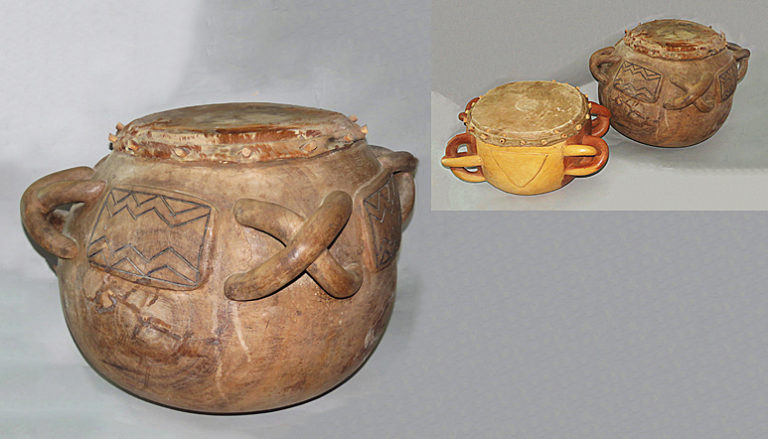
Owner: HWMC
Catalog#: 2AF-MBST-48
Provenance: Lionel Finneran, who collected the drums from the Venda drum maker Simon Mikosi; Axis Gallery, Gary Van Wyk, Ph.D. Curator
Single-headed Drums
Venda ‘Ngoma’ (Drum)
South African-Zimbabwean border
Venda Drum Maker: Simon Mikosi
Ox-hide, Imbuia Wood
Large ngoma – Height: 22 in; Diameter w/handles: 31.5 in – 79 lbs
Smaller thungwa – Height:14.5 in; Diameter w/handles: 29 in – 49 lbs
Membranophone – Struck – Single-headed Drum
The Venda people, like many of the tribes in South Africa came from Central Africa. Their mythical culture is closely associated with the spirit world, which is clearly expressed through their art designs on structures, pottery, and woodcarving.
The construction of the large Venda drum, called ngoma or ngoma lungundu (referring to the thundering sounds) consists of four parts: at the bottom a raised ring surrounds a small hole; above is the main hemispherical resonator pot-shaped body carved out of solid wood; the upper portion (shoulder) of the drum is ornamented with four ‘handles’ which interlace in pairs; and the mouth is covered by an ox-hide that is stretched between pegs around the circumference of the rim. This ox-hide drumhead is played with a stick. The space between the handles of the larger drum consists of a band of zoomorphic (python) relief carvings represented by the zigzags. The smaller drum, called ‘thungwa’ displays a triangular shield on one side and a plain rectangle band on the opposite side. The drums are of considerable weight.
Venda drums (ngoma) are often given personal names and are kept in the homes of chiefs and headmen.
According to Gary Van Wyk, Ph.D. Curator Axis Gallery:
“These Venda drums are used for specialized communal events, particularly for rainmaking and for the Domba, a communal ceremony for women’s initiation that features a python dance. When played as a set of drums used for rainmaking, they are called a “herd,” evoking the tie between rain and a fat and healthy herd of cattle, which are also used in sacrifices to the ancestors to appeal for rain and other blessings” (Anitra Nettleton, expert on the Venda).”
